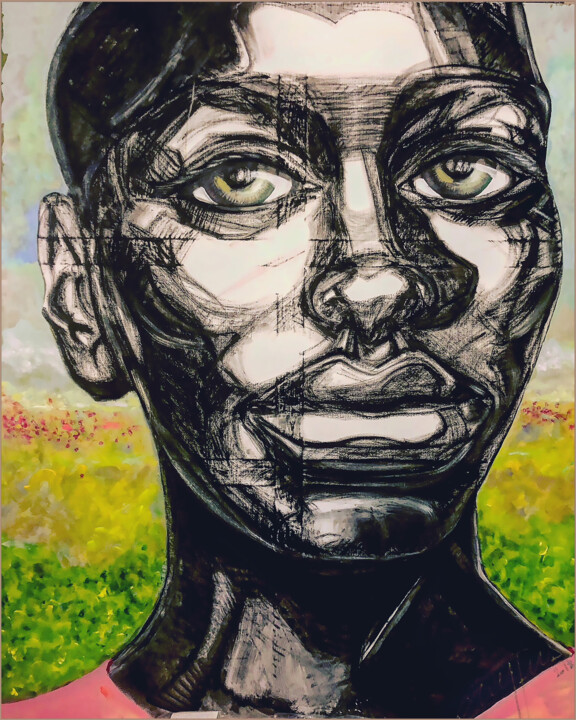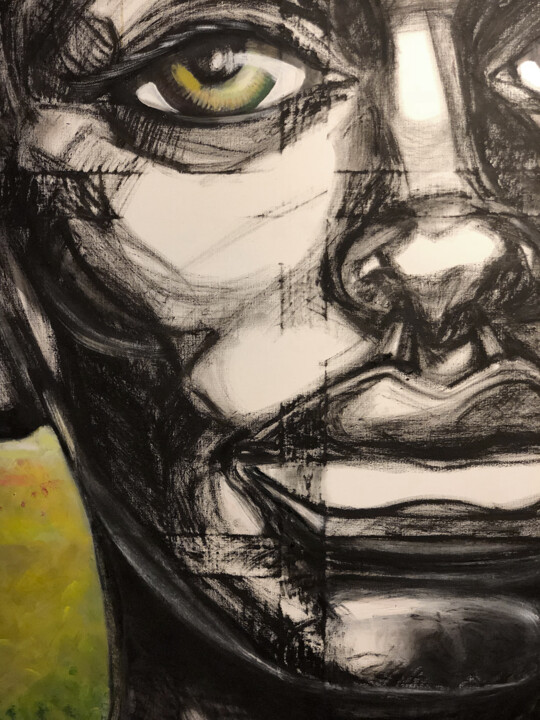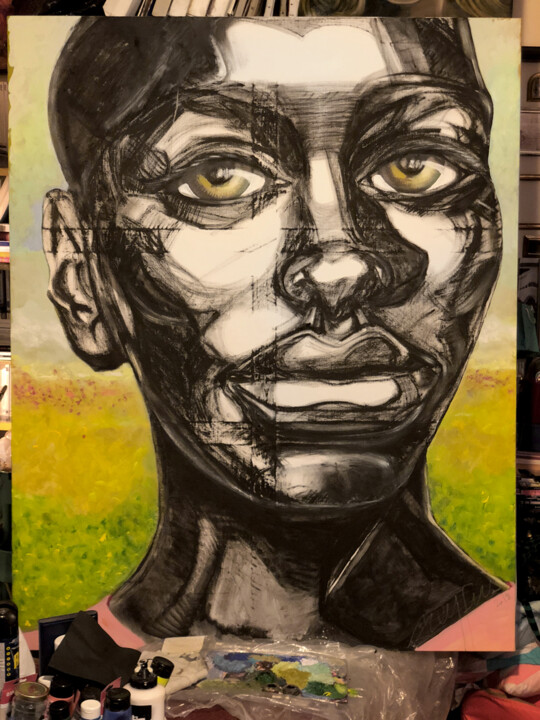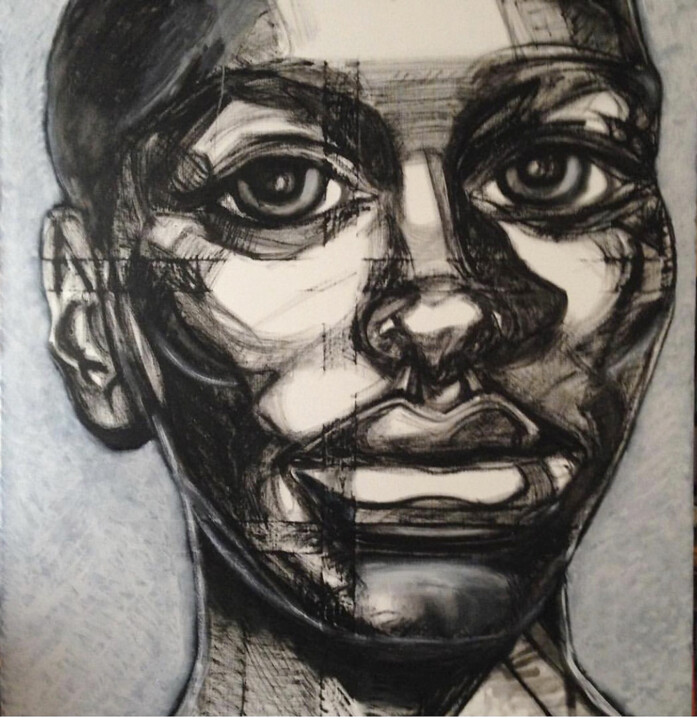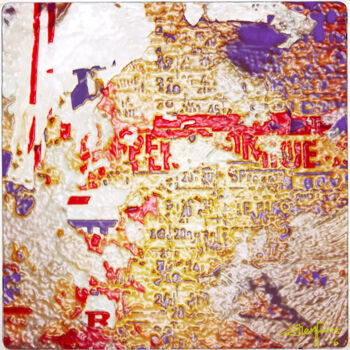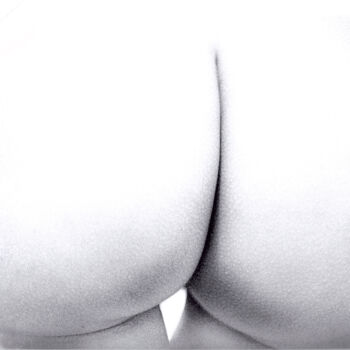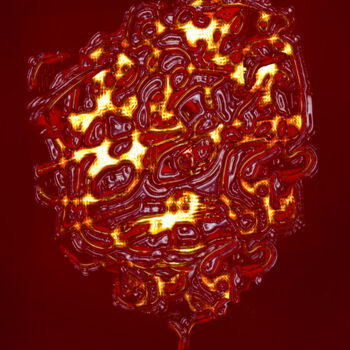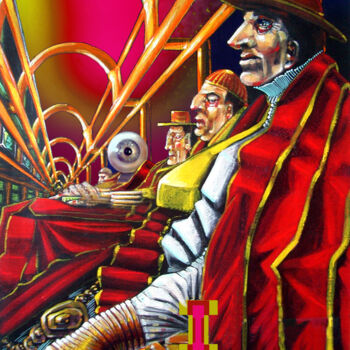" OUIDAH CHARLESTON " - Série COMMOTIONS n•11 (2017) Painting by Grégory Dreyfus
More info
- Packaging (Box or cardboard packaging) All artworks are shipped with a premium carrier, carefully protected and insured.
- Tracking Order tracking until the parcel is delivered to the buyer. A tracking number will be provided so that you can follow the parcel in real-time.
- Delay Worldwide delivery in 3 to 7 days (Estimate)
- Customs not included The price does not include customs fees. Most countries have no import tax for original artworks, but you may have to pay the reduced VAT. Customs fees (if any) are to be calculated on arrival by the customs office and will be billed separately by the carrier.
More info
- Trackable Online Certificate of Authenticity Authenticity Certificates can be verified online at any moment by scanning the artwork code.
- Artist Value Certification Experts study the work and career of an artist then establish an independent and reliable average price value. The average price value situates the artist on a price range for a given period. The experts may also be asked to establish a more precise estimate for a particular work.
More info
100% secure payment with SSL certificate + 3D Secure.
More info
-
Original Artwork (One Of A Kind)
Painting,
Oil
/
Acrylic
/
Charcoal
/
Tempera
on Linen Canvas
-
Dimensions
63.8x51.2 in
Dimensions of the work alone, without framing: Height 63.8in, Width 51.2in - Framing This artwork is framed
- Categories Paintings from $20,000 Figurative
“Beauty Malice” and the fields. All the beauty in the world.
Contemporary walks and migrations of the ages.
A through and difficult look at its history...the “Slave Route”.
This path by which his ancestors were taken to join the slave trade ships, at “Gate of No Return” in the 18th century.
Ouidah denuded village, southern Benin, bears the memory of the atrocities perpetrated.
He was told... - The year 1848 put an end, by decree, to the slave trade on behalf of France and its colonies and yet.
Elsewhere slavery would continue.
In the kingdom of Abomey, orchestrated by the slave trading state of Abomey and on behalf of Europeans, in the villages, raids and the sale of slaves, described as “goods”, took place in the most inhumane conditions which be.
Nearly 2 million of the 11 million uprooted by Western trafficking.
More than half were from Lagos and Ouidah, the two main ports.
After their captures, in the middle of this place where this centuries-old tree, the tree of oblivion sat enthroned. A ritual was practiced there intended to make the men and women, sold as slaves, lose all bearings.
The men had to circle nine times and the women seven times around the tree which would make them forget their culture, their past and their homeland (this figure was determined, in relation to the beliefs of the people of the time that the men possessed). , nine ribs and women seven).
Their fate no longer belonged to them on the sales shelves as the magic of ritualized beliefs then forced them to live and integrate the perversity of induced, dissociative experiences of depersonalization.
Before traveling the few kilometers that separated them from the boats, the slaves were branded with a letter, a sign of the country to which their new buyers belonged.
In order to then test their resistance on the boats during the crossing, they were locked up for several weeks or even several months in small boxes, where the almost total darkness would completely alter their dimension of existence. Those who died or were no longer able to make the crossing were thrown into mass graves. Those who remained, chained to each other, covered the few kilometers that would separate them from the beach to board.
Thousands of ships like the "Clotilda", the last to leave loaded with hundreds of slaves in 1860, crossed the Atlantic until taking "their goods" to the port of Charleston.
In 300 years nearly 400,000 slaves were brought to the North American continent by the French, English, Danish, Dutch and southern Europeans and then, all the Eastern allies, when and already, Portuguese and Spanish in the 16th century, brought them already, Asians and Africans, in South America.
The slave market would feed the plantations in the southern United States.
A population of 11 million from Africa would discover that they "wouldn't have" souls here.
Colonial era of “non-enlightenment”, where a hierarchy between men and “non-men” is dominated by the spirit of this white man.
Hope came in the Declaration of Independence on July 4, 1776.
But it is individual freedom and equality between white men that is declared.
The universal declaration of human rights... in 1789 will concern only a few men other than Europeans.
For the Constitution of the United States of America of 1787, only the states decide on matters of slavery. So nothing will change in the southern states.
And although in Virginia, as elsewhere, the emergence of reforming, emancipatory ideas from the European humanism of the Age of Enlightenment is making headway, and even painfully...The right to belong, literally "of life or death "on another being or on other human beings, institutionalized in this destiny is maintained and remains the cultural, institutional, fundamental cornerstone of the southern states.
However, the first so-called republican and non-theological university, promulgating above all sciences and philosophy, in Virginia by Thomas Jefferson, author of the Declaration of Independence, was founded.
We are beginning to knit an educated, emancipated America, ready to reveal a form of social egalitarianism, even if this is always borrowed, and strongly, from a certain "libertarianism", where everyone is responsible for their choices, their life and his death - and therefore his "misfortune" was it to be a slave, but for which no one, and even less the state, has to dictate conduct in this "pursuit of happiness".
Rejecting all forms of authority, but since it is supported by a falsely theological idea, this libertarianism uses the rights of democracy against it, by imposing their unbearable, populistally deceptive, radical and “racial” nostalgic ideas, respondents of a misleading and obscurantist vision of Christianity, deploying growing power.
1804: Slavery is not abolished in the southern states.
1807: The American Congress nevertheless votes to ban the importation of slaves.
1830: The “Indian Removal Act”: Law for the deportation of sovereign Native Americans on their territories in the east is passed. And nearly 70,000 Indians are thus forced to abandon their lands which have become illegal, located between the 13 founding states and the Mississippi, so that the settlers can occupy and actually buy them.
This deportation: "the trail of tears", was particularly...brutal.
...
(to dev)
1860: Le Clotilda is burned
...
Civil War between 1861 and 1865.
North wins South & Delivers the plantations, but slavery nevertheless remains in the Southern states.
In 1863 the 13th amendment to the constitution abolished slavery, but under conditions.
Jim Crow laws and Separatism.
or how to “Save your humanity in the era of Jim Crow (1865-1915)”
“Freedom, at last! “It was June 4, 1865, that I began to live,” former slave Katie Rowe declared in 1937 to the person who came to collect her testimony of emancipation. The day she learned from a Northern “Yankee” that she and the 200 slaves with whom she had worked in the cotton fields since childhood would now be “their own bosses,” a new life began. opened, with its uncertainties and its difficulties but with this new treasure cherished at its true value. The dream of generations of slaves and former slaves had come true. Once the abolition of slavery was confirmed by the ratification of the 13th Amendment to the U.S. Constitution in December 1865, the 3.9 million blacks in the American South (more than 90 percent of the total black population) now freed people never stopped wanting to enjoy their recent freedom and seeking equality and justice.
But heavy threats weighed on them. When Republican President Abraham Lincoln was assassinated on April 14, 1865, his vice president Andrew Johnson, a Democrat from the slave state of Tennessee and a firm believer in white supremacy, entered the White House. With his approval, the white democratic elite, returned to power at the end of hostilities in all the states of the former Confederation, hastened to adopt “Black Codes” which very severely regulated the freedom of African-Americans.
To prevent the reestablishment of a situation of subjugation of blacks similar to slavery but which would silence its name, the Republicans who controlled the Congress (composed of the Senate and the House of Representatives) in Washington imposed, against the advice of the president Johnson, a special regime of government with military occupation of the Southern States while "reconstructing" the South and fully reintegrating it into the Union on the basis of acceptance of the 13th Amendment..." Caroline Rolland-Diamond
...
1915: Release of the film “Birth of a Nation” by D. W. Griffith, lastingly fueling devastating racist stereotypes about Black Americans.
The film is adapted from the counter-novel written by Thomas Dixon in 1905 to the glory of the Ku Klux Klan: "the Clansman" therefore coming directly against the famous abolitionist novel "Uncle Tom's Cabin" by Harriet Beecher Stowe published in 1852.
"Birth of a Nation" book and film featuring: the good guys, the bad guys... "the bad blacks attacking the good white victims"... - film of perfect perversion: through cognitive biases, simplifications , idea of rediscovered purity, fraternal nostalgia for the world before, loss of values and "derealization" which would provoke this new search for power and justify everything.
It is the first of the films, focused on the populist fantasy of an ignorant and therefore ultimately bestial white America. With in fact:
_"concrete and devastating repercussions. It exploded the number of assassinations, rapes and attacks against blacks. For Donald Bogle, a historian of American cinema who was one of the first to study the consequences of Birth of a nation for black Americans, this film had a lasting influence on racist representations. In his book "Toms, Coons, Mulattoes, Mammies and Bucks", he explains how the film took pre-existing stereotypes and rendered them. dominant." Barbara Marty
With a more poignant melodramatic story as if a new reality, non-fictional but hidden (of conspiracy) was finally exposed, joining a sweet dream of a deeply ingrained ideology of slavery racism and which would thus take shape among the unbelievers too.
A quarter of Americans saw this first openly racist Blockbuster.
("The truth would be a genre like any other and we can make it say whatever we want, as long as we support it enough and people believe it")
Rebirth of the Klan:
_" “Birth of a Nation” is a film that is both fascinating because it is a cinematographic masterpiece and that is undeniable, and very problematic. (...) If we arrive to go beyond racist ideology, if we have an open mind, we see that it is a film which is extremely well told and which makes the public adhere to its ideology, with a first part which plays on the brotherhood of a lost world, emotions of endearing characters, and it is only from the second part that the truly vicious racism takes over (...) The "Birth of a Nation", whose title is. somewhat enigmatic, is in fact the rebirth of a white nation and the birth of the Ku Klux Klan.
(...) This film relaunched this organization which was losing momentum and will experience its hour of glory with the most horrible statistics on the number of lynchings.
The Ku Klux Klan is an organization that is recreating itself worse than in the aftermath of the Civil War, if that were possible. Worse in the sense that they are no longer content with wanting to keep black people in slavery despite emancipation. They will attack all kinds of minorities, in the spirit of the coming Nazism. When we read “Mein Kampf” by Hitler, published in 1925, it does not only target Jews, it is a gradation of populations that must be eliminated to preserve the Aryan race.” Anne Crémieux, professor of American civilization.
The film has concrete and devastating repercussions:
It explodes the number of assassinations, rapes and attacks against black people.
Paradoxically...because he was rebellious: he gave birth to independent black cinema.
...
In the 1950s, segregation raged, with governors of southern states banning or organizing confrontations to prevent blacks from entering universities.
1954: Advent of school laws
Civic movements or the birth of hope and the march for equal rights.
...
1960: - JFK president.
- Boyton vs. State of Virginia (1958, a young black law student is arrested at Richmond station for ordering a coffee at the white counter. The case goes to the Supreme Court and favors Boyton)
1961: In the name of "Freedom right" - and non-violent civil disobedience. Some blacks will test this judgment in the southern states.
1963: "I have a dream". Martin Luther King.
Indeed... "The struggle of the civil rights movement, which began in 1950, to obtain in law and in practice the end of inequalities between white and black Americans, is long.
Great March for civil rights for black Americans, August 28, 1963 in Washington at the Lincoln Memorial where MLK gave his speech.
Desegregation was one of President John F. Kennedy's fights.
At the beginning of the 1960s, the daily life of the black American population was made up of inequalities and discrimination in many areas. The struggle and protest of the civil rights movements eventually translated into laws.
Segregation in public places persists.
Blacks suffer numerous discriminations and exclusions in public places and services (trains, buses) due to segregationist laws - Jim Crow laws established in 1876. Segregation between whites and blacks is also practiced in certain theaters and restaurants. So in 1960, black students in North Carolina, in Greensboro, staged a sit-in for six months in front of a restaurant before being able to be served there.
It was not until the adoption of the Civil Rights Act, signed by President Lyndon Johnson on July 2, 1964, that all forms of segregation were prohibited in public places. But attitudes are slower to change than laws in some places, necessitating the continued fight to enforce the Civil Rights Act.
Discrimination in hiring.
Employment discrimination is very real: certain jobs are held only by whites and remain inaccessible to blacks.
It was the Civil Rights Act of 1964 that ended employment discrimination. This law prohibits discrimination based on race, color, religion or sex. It also establishes positive discrimination: employers must ensure that they achieve or maintain hiring quotas in favor of blacks.
The federal government, since a March 6, 1961, executive order by President John F. Kennedy, has required federally funded programs to ensure that employment is not subject to racial discrimination. But in reality, inequality of opportunity in hiring is very real. And on September 24, 1965, President Johnson signed an executive order ordering companies working with the state to take “affirmative action” measures to increase the chances of access to employment for minorities.
Access to university.
James H. Meredith, escorted by police officers, arrives at the University of Mississippi in September 1962.
Since the Brown decision of the Supreme Court in 1954, school segregation has been prohibited, but access to university is still impossible in segregationist states.
Thus, federal intervention was necessary to allow James Meredith - the first black student enrolled at the University of Mississippi - to join the campus in September 1962, supervised by the police. Throughout his education at Ole Miss University, he was protected by federal agents.
Mixed marriages.
Laws prohibiting mixed unions between whites and blacks lasted until 1967. The Supreme Court's ruling Loving v. Virginia which declares the ban on intermarriage unconstitutional.
The hard-won right to vote.
Recognition of the right to vote for blacks was one of the main demands of the American civil rights movements in the 1960s. In theory, as early as 1964 and the signing of the Civil Rights Act, discrimination in the electoral process was over. But segregationist states prevent this right through tests or taxes. It was not until August 6, 1965 and the adoption of the Voting Rights Act which authorized the federal government to ensure that blacks could register to vote that this gradually became a reality for all black Americans.
Access to housing.
Although housing discrimination is prohibited, it persists in some states because there is no federal provision to verify this prohibition. In 1968, the Fair Housing Act prohibited discrimination in the sale, rental and financing of housing based on race, color, religion." Véronique Laroche-Signorile
1963-1975: Vietnam War... and this sociology of the underprivileged who are sent to the front.
...
Selma, Alabama, March 7, 1965: The Pacific March, where the majority of women and children also marched against this unbearable racism demanding only fair respect for their rights, was severely repressed, and filmed live on television: "violently "unheard of" he said, a historic turning point in the movement.
Therefore, due to the right to vote finally granted to blacks... "white" public schools must integrate them against the advice of governors and police and constituents of the states. “The resistance is such” in these pro-segregationist states that “it is up to the army to come and protect the first black students who go to university in Alabama”.
...
Summer 1967 turning point: revolt in Chicago. 200 people killed.
...
1968: MLK is assassinated
...
Bob Kennedy, the hope of a power that could be reconciled, was also killed.
...
It was only in 1970, in Selma, Alabama, that the first mixed class was created with difficulty.
Harassment, bullying, insults, attacks... against blacks and whites who support them.
The families who can move, the others... see their white friends and their parents leave.
While the John Tyler Morgan Academy was created in the decade in reaction, named after this pro-slavery senator and infamous member of the KKK... . The school is still open 50 years later.
etc
etc
...
1991 Rodney King is violently beaten by 4 police officers surrounded by other police officers, filmed without their knowledge, the information goes viral. The police officers will be acquitted - trial and acquittal = 6 days of riots.
School failure, poverty, stigma, crime is exploding...
_"education and prison are inversely proportional" Nirmala Erevelles - professor of Sociology, University of Alabama.
Also due to the privatization of prisons, required by boards of directors to 'be efficient', like those of hospitals elsewhere, blacks will fill some and be excluded by a system of care of others from which they will not be able to benefit without being from a wealthier and therefore educated social class.
Desegregation begins to fail, while almost from these generations of progress, 17 years later, the first black president is elected.
However, racial and social tensions persist...
The Black Ghettos and declassification too...
This new Apartheid of education continued insidiously to grow in the 90s. By pushing amendments and screws here and there, visibly unnoticed, in the equivalent of our “national education”, which will unravel everything that had been built, woven with good since civil rights during the Jimmy Carter and Ronald Reagan era.
Indeed...During the Bush/Clinton era, "judges all over the country who considered that racial integration was a success" - and it was - "...decided, on their points of view, that the laws introduced in the 60s to force diversity were no longer necessary. In Selma as elsewhere, the law is repealed without anyone really paying attention to it.
A generation was able to experience so-called "racial" diversity to bring together whites and blacks in the idea of a single progressive voice, of full and real equality in freedom, hard-won everywhere and particularly in the southern states.
A social mix in universities, in which one or the other of the two populations would no longer oppose each other out of distrust or fear, but would literally learn de facto to live together, without the feeling of not being in their place.
It was simple, an acquired right, a civic equality of rights and opportunities for everyone, everywhere.
And then, through this unnoticed amendment, through this unraveling of social and racial diversity, the beginning of a return to so-called "segregated" high schools and universities took place, a growing economic divide and the slow entry into a post-secondary era. -truth where lying and misrepresentation would only be "alternative" facts in self-service to the right to be expressed as a right to lie and uninhibited racism.
Conspiracies, fake news, double talk, slander, authorized lies tweeted and re-tweeted, the Cambridge Analytica heist and the sordid strategies to target Facebook users, to Russian hackers (ultimately proven) against the Clinton campaign... In short, all the factors of obscurantism in this new populist, re-segregationist order reappeared. And by that a counter-revolutionary rewriting and rereading brought about by the “altright” after the “tea parties”, I mean. Today, the "Trumpist" conservatives are returning to the ranks of the dominant and demanding in so-called Christian or evangelical universities of all stripes who now make the law as holders of divine and political power. ...To bring out a libertarian anti-Enlightenment spirit, fundamentally traditionalist and anti-abortion for example.
"Traditionalists" intimidating some in the aisles of universities, legitimizing others, pure extremists, white supremacists who besides neo-Nazis or Aryan gangs, remain obviously linked to the KKK... to the militias, "proud boys " who do not want to be racist but "manly"... all seeing in Trump an almost Christ-like savior.
Concluding from there, universities for blacks, separate from universities for whites. A separatism now well defined between them, in all sectors and fringes of society.
...
Later,
Trump, who used racist, sexist, homophobic, disabled, misogynistic doublespeak... legitimizing violence, intimidation and division, is elected.
He will continue to evade numerous attempts to be removed from office. He will repeal in Congress, "Obama Care", thereby literally breaking the American health system for the most deprived and will make references to "the good old days when blacks stayed in their place and when we were able to get them out very quickly": america great again.
...
Segregationist demonstrations which degenerate like in "Charlottesville", where a woman is run over by a car... to the abuses of certain police with real "assassinations" or preventive shootings in the back... without any warnings or judgments nor fears so to speak, and tragically and furiously black people die every day under gunfire or to be subdued as recalcitrants? - who was wrong... Seriously.
Among the 18,000 locally or regionally elected police forces in the US, the police are institutionally still racist...
Michael Brown, Trayvon Martin, Eric Gardner, Keith Lamont Scott, Freddie Gray, and so many others...and then George Floyd "I can't breathe" died of suffocation under the knee of a police officer who preferred to do nothing. .. - Revolt throughout the world.
#Blacklivesmatter, the movement is gaining momentum.
Trump, 45th president of the United States, divides America in two, even more deeply.
And already refuses in advance, the potential and possibly future victory of his opponent under the pretext: “that if he wins, he will have cheated!”
Biden wins: Attack on the Capitol by supporters of Trump, this sociopath (a near antichrist), attacking the symbol of “The Republic of the United States.”
A republic which was built against tyranny, with a first power as it appears in the Constitution, being the legislative power,
hence the importance of the Capitol which is the house of the people, in a system which is the government of the people, by the people, for the people. »Anne Deysine.
For the professor of American civilizations Cécile Coquet-Mokoko, “the Capitol is very symbolic because of the institutions it houses: the Congress [the Senate and the House of Representatives, Editor’s note], and it is indeed this symbol of American democracy, which was attacked on January 6, 2021, she tells us. In the history of the Constitution, Congress is first supposed to represent the American people in their diversity and to initiate laws. Which is no longer necessarily the case today. »
The Capitol is the great symbol of American democracy, historically essential as being this “high place of power”.
It is dismaying to see the greatest democracy in the world deteriorating, precipitated like an America which can sink further and further...
Brief...
...Great granddaughter of slaves, university student, Malice looks at this journey through the ages with pain and the strong realization that everything has to be rebuilt, alas, but with unfailing determination, she operates and projects in this vision, its horizon.
A field of evolution, she hopes.
The fight against poverty. For emancipation, through Education, in favor of health coverage for all, for Civil Rights. Dynamically against this systemic Racism. And on legislation regulating firearms.
...
Its horizon chiseled with these tears, old souls.
©2019/2020-byGrégoryDreyfus
REFERENCE INDICES:
_"Remember This House", James Baldwin.
_"I'm not your negro", James Baldwin,
_"Black America, a history of struggles for equality and justice (19th – 21st century)" Caroline Rolland-Diamond - La Découverte, 2016
_"Birth of a movement", PBS documentary produced in 2017.
_"D. W. Griffith's the Birth of a Nation", by Melvyn Stokes, published by Oxford University Press in 2008.
_"Black American filmmakers and the Hollywood dream", by Anne Crémieux, published in 2004 by L'Harmattan.
_"Toms, Coons, Mulattoes, Mammies and Bucks: An Interpretative History of Blacks in Films", by Donald Bogle, published in 1973 by Viking Press.
_"At the origins of the first racist blockbuster" By Barbara Marty - France Culture.
_"Long march of civil rights" - figaro History files, by Véronique Laroche-Signorile, 2015.
_"United States, the new apartheid" Documentary film by Romain Icard - Nilaya Productions 2016.
_“The United States and democracy” published by L’Harmattan - Anne Deysine, specialist in the United States.
_"Ouest-France, Evening Edition - “Why is the Capitol the great symbol of American democracy?“ By Édouard LAMORT
Related themes
Grégory Dreyfus decided very early on to become a painter. The obvious, an artist, but not only... An actor, an author, a director, a director, a photographer... A sort of family atavism which was to be gloriously balanced in art, by the action of one as by the action of the other. Dancer, mime, designer and singer were, however, his first living expressions.
After 4 years spent studying art and design at the JULIAN Academy and the school of graphic art and interior architecture, “Met de Penninghen” in Paris. And after having been the apprentice of one of the last great alchemists of oil painting. Or ambitious for having been approached, the Magnum photo agency in NY as photographer. ...Meeting masters, maintaining exchanges with great artists. Passionate about the History of ideas, self-knowledge... - A pronounced taste for Asia. But living in particular in London, Paris, NY and Taipei - He never stopped working to develop his creation, linking their very actions in all aspects.
Drawing, painting, playing, dancing, framing, installing... launching into transversal work, as an actor on all forms of theater stages as well as film sets - author, director - director... and visual artist. Thus nourishing each “act” of creation from one to the other, he jointly amplified this creativity.
...At the same time, he embraced the world and industries of advertising, music, theater and cinema at different levels of creativity and responsibility.
...Leading like a weaving, this multi-body work with a thread of happy subsistence, in a life of perpetual advancement. ...Linking very often, always developing, constantly projecting, in the transversal perspective, this long-term "movement".
Today, he leads all the battles head-on in the balance of an almost musical dialogue...And in short! ...To simply make a work.
-
Nationality:
FRANCE

- Date of birth : unknown date
- Artistic domains:
- Groups: Contemporary French Artists

